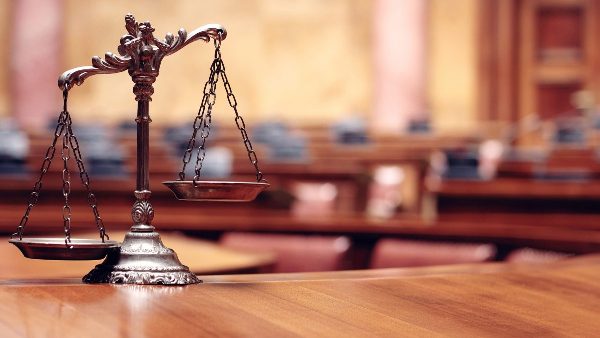Question Mark Over Quality of Judicial Officers
READ ALSO: India’s Judiciary and India’s Security
The most prevalent perception among the educated is that, of the three basic organs of government – the Legislature, the Executive and the Judiciary – the judiciary is the most reliable and honourable. Most consider it as the instrument of last resort in a civic way, which indeed it is. It is, alas, also a very wrong perception. A legal profession is like any other government job and that a judge or a lawyer is not much more than another sarkari karmchari, with all the faults, foibles and frailties of such karmcharis! Being the people that, by profession, sit on judgment over others, they become pompous, grandiose, easily offended and highly touchy about their status. The power of the chair they sit on percolates to their persona so effectively, they presume they are law unto themselves. Let us examine the genesis and evolution of judges to understand their psyche.
A legal profession is not among the top choices of youth in India who crave to be doctors, engineers, bureaucrats, information technology (IT) professionals, pilots or even faujis. In India, there is cut-throat competition for admission to the limited seats available for the prized courses that lead to dream jobs. Those that fail to make the cut are obliged to seek alternate vocations. Here too, chartered accountancy, company secretaryship, corporate jobs, teaching, banking, etc, hold primacy over a legal profession. Verily, a course in law is for the stragglers or those that have an eye on politics. Evidently, the brightest or the most motivated of youth do not even vie for a legal job. Of the 20 lakh odd lawyers in India, most of them earn a frugal earning as notaries or typists outside courts. A large percentage is jobless. Those that make it big are the ones practising in High Courts (HC) or the Supreme Court (SC). Almost all of them are dynasts. There is as much divide between the earnings of SC/ HC lawyers and the rest as is between our Men-in-Blue and the Ranji Trophy cricketers.
The path from a newly graduated lawyer to a HC lawyer is so steep that only a dynast or a truly remarkable candidate can make it. The rest spend their lives drafting papers in law firms, providing legal advice to corporates or teaching law. Nearly 35 per cent of all lawyers never get to see a courtroom except in moot courts or in movies.
India has adopted the British model of administration since Independence. Britain, at that time, was a world-ruler and had two widely varying systems of governance; one for home and one for the subjects abroad. Like the police, the judiciary inherited by India is from the latter category that did not “administer justice to its citizens” but one that provided “recourse to law to alien subjects”. Being an alien occupant of India, Britain did not care if justice was being dispensed by Indian courts so long as the interests of the Crown were safeguarded. Alas, India has allowed the inertia of The Raj to continue for over 70 years.
Aware of the low strata of intake of people into the legal profession, it was expedient for the British monarch to project an image of knowledge, integrity, honesty and material well-being of its officers of the court. Consequently, steps were taken to show up lawyers and judges as personages of an elite stratum of society. Lawyers were attired in flowing black gowns with white collars and white wigs to signify richness and wisdom. They were to be addressed as “learned” to depict knowledge. Judges were dressed in even richer red robes, with white collars and wigs to project an image of aristocracy. They were paid handsomely and given a high order in the warrant of precedence. They had to be addressed as “Milord” or “Your Honour” to bestow an image of infallibility and impartiality. The judges sat on well-adorned throne-like chairs on a high platform with well-embellished guards on either side. The arrival and departure of the judge was done in imperial style, with a formal announcement invoking “all to rise” in the judge’s honour. The judges enjoyed unquestioned authority in the courtroom making the other mortals look up to them in much reverence, awe and fear. A swan needs no make-up; a crow certainly does. The necessity to so spruce up the judge and the court officers itself betrays their true worth and capabilities.
Without the robes and wigs, judges are as human as your next-door neighbour. The power vested in the judges is so huge as to be almost tyrannical. They can question anyone but no one can question them. They can castigate, lambast, chastise, rebuke, reproach and reprimand anyone with no fear of a riposte. If anyone offends their majesty, they are armed with the brahmastra of “contempt of court” that empowers judges to send anyone to jail, without trial!
This unbridled power lends itself to easy misuse. Judges are not beholden to anybody or anything. They have no working hours. Nobody to question them if they arrive late or if they rise early. They can grant recess anytime with no care for the urgency of the case or inconvenience to the plaintiffs. They are not accountable for any delay, though they, along with the lawyers, are the prime reason for inordinate delays in dispensing cases. Everyone knows “Justice delayed is justice denied,” except the court officers. Perhaps, there is no chapter on the fundamentals of justice in any syllabus of law colleges.
Law, it is universally known, is a matter of the letter, not the spirit. Examples abound where the letter-of-the-law has ridden rough-shod over the most elementary of logics and demands of justice.
Justice is not blind; the judges who dispense it are. If letter-of-the-law is supreme, it is incredulous how the judgments of lower courts are frequently reversed by sequentially higher courts. How can words be open to interpretation? The malaise clearly lies in the intent of the judges passing verdicts. Obviously, matters other than the law are at play when cases come up for judgment. This is a sad commentary on the honesty and integrity of the judges. John Dalberg-Acton must have been thinking of judges when he wrote “Power tends to corrupt and absolute power corrupts absolutely!” Indeed, save a few, almost all judges are corrupt to varying degrees.
If efficiency is defined as optimal utilisation of resources with minimal wastage and if time is a resource, then no other organisation or collective is as inefficient as our judiciary. Judges and lawyers have no value for time except when the latter are billing you for it. Arriving late and leaving early, never working overtime, enjoying every festival and vacation, adjournments and postponements of hearings are all synonymous with court work. Court cases taking two to three decades fail to evoke any surprise.
The burgeoning cases pending in India can be resolved, albeit gradually, if the courts started working overtime; like they do when granting bail to a Salman Khan, around midnight on a Friday, to ensure the celebrity does not spend the weekend in havalaat. They could cap the number of postponements of hearings for all reasons to a reasonable number and set a deadline for disposing-off of cases. There is no reason courts cannot have Standard Timelines for resolving cases like rape cases in 15 days, murder cases in two months and civil suits in six months, etc. Clearly, the endless dragging of cases and under-trials suffering in judicial custody, a euphemism for jail, for long periods does little good to the judiciary’s image. Cases burgeon for a variety of reasons, not just the slow pace of judicial work. A major reason for piling up of cases is the appellate procedure open to all who lose a case. Almost every case goes for appeal at every echelon available. Shortage of courts contributes too. With just 25 High Courts for 28 states and 8 UTs and with only 544 district courts for 741 districts there is a partial vacuum of court availability. Shortage of judges adds to this problem. With 419 vacancies in SC and HCs and 4,928 vacancies in lower courts (as of March 2021), the Indian citizen is truly abandoned. Most good lawyers are averse to becoming judges as it means financial demotion. Naturally, the lower strata of lawyers, with none too flattering a legal career, are available to become judges. We come back to incompetent persons occupying judicial chairs.
It is interesting to see how judges are appointed in India. The Collegium System is followed not just for appointment, but also for promotion and transfer of judges for the SC. The Collegium comprises of the Chief Justice of India (CJI) and four senior-most judges of the SC. The HC judges are appointed by the President of India on the advice of the CJI and the district court judges are appointed by the governors, on the advice of the HCs. So, it is pretty much an in-house system which is totally opaque. The other organs of the government, the Legislature and the Executive, play no part in it nor can question it. The Collegium System was introduced in 1993, ostensibly to eliminate the primacy of the Executive in appointment of judges. Apparently, it was introduced to create a battery of pliable, unscrupulous and weak judges owing loyalty to the ruling party of the time. This system was replaced by National Judicial Appointments Commission (NJAC) by the Modi government in 2014. The NJAC comprised of the CJI, two senior-most SC judges (after the CJI), the law minister and two eminent jurists. This was aimed at addressing the preeminent flaws of opacity, nepotism and malfeasance deeply embedded in the Collegium System. The SC, however, struck down the NJAC in 2015, declaring it unconstitutional as it purportedly transgressed the independence of the judiciary. So much about probity, transparency and morality of the judiciary.
The low esteem in which the Judiciary is held in India manifests itself in the standard of judges seen even in TV reality shows. Choreographers who cannot dance are judging India’s Super Dancer, singers who are worse than contestants are judging Indian Idol and even an international franchise like Master Chef India had Akshay Kumar (actor) and Farah Khan (choreographer) as judges on a cookery show. The case rests itself, milord!
The prolonged placement on a high pedestal has made the judiciary passionately believe in the superiority of its own capabilities and competence. This is ironical considering they come from a nursery of average under-achievers in comparison to those that become doctors, engineers, IT pros, bureaucrats, pilots, CAs, etc. Their misplaced sense of métier leads to judicial-activism with ludicrous consequences. Today, during peak of the Covid-19 pandemic, SC and HCs are asking the government to provide hospital beds, oxygen, vaccines, etc, to the entire Indian population within three days or else….. you guessed it, contempt of court! This, in contrast with the judiciary not being able to establish in 19 years whether Salman Khan was driving that SUV! If shamelessness has any limit, it evidently does not apply to our judges.
How does the Judiciary affect India’s Security?
Judicial intervention becomes necessary whenever there is a conflict. When a government tries to do something evidently good for the country and her citizens it is at cross-purposes with the internal and external enemies of the nation, creating a conflict. Similarly, when a government does anything bad for the nation or her citizens, people and certain pro-nation organisations rise up in protest, again creating a conflict. It devolves on the courts then to resolve all such conflicts. If the courts are not secure, ie, they are not committed to the nation, the Constitution or the interests of the citizens, they can cause untold harm to the security of the nation. A nation may be harmed both by giving a biased adverse judgment as well as by withholding a judgment for prolonged periods.
Judges in India are appointed, not elected. They, therefore, are likely to be beholden to the powers that appointed them. The appointing powers obviously choose the most pliable and unscrupulous from the available candidates. This breeds a system where justice is sacrificed for the benefit of the powerful. There are numerous instances where courts have been used to harass innocent people as well as liberate hardcore criminals. As chief minister of Gujarat, Narendra Modi was continually harassed under numerous legal cases, which ultimately fizzled out but did inflict anxiety on him and hindered the progress of Gujarat. The judgment on Ram Janambhoomi case was kept in a limbo for decades as it would have gone against the Muslims, while rulings on banning firecrackers on Diwali or other Hindu festivals as bull-racing on Jallikattu have been delivered with promptness. Repetitive judgments that tend to favour Muslims at the cost of Hindus hangs a question mark on the impartiality of the judiciary. This impression is further strengthened when one realises the high percentage of “uncle judges” in our higher judiciary. The Punjab and Haryana High Court boasted of 34% judges with close blood relationship to the lawyers practising in that court, ie, every third HC judge was an uncle. Other high courts would have similar percentages.

















